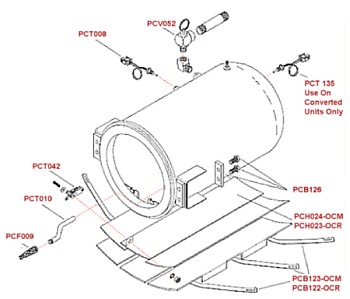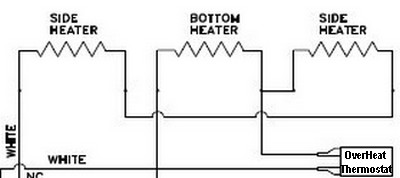"How To Find The Source Of Heating Problems With Your Pelton Crane Sterilizer "
 WARNING: UNPLUG THE UNIT BEFORE PROCEEDING & LEAVE IT UNPLUGGED
WARNING: UNPLUG THE UNIT BEFORE PROCEEDING & LEAVE IT UNPLUGGED
Remove the cabinet by removing the screws from the bottom of the sides and the back. Once the screws are removed, lift the back of the cabinet up slightly and push it forward (there is a small lip in the front that is about ½ inch wide that must be cleared before you can remove it).
Once the lip is cleared, just lift the cabinet off and set it aside. You will want to remove the insulation surrounding the chamber. Just lift it off and set it inside of the cabinet so it is out of the way.
Do A Visual Inspection First (Your problem could be as simple as a loose or broken wire). Check all of the wires around the controls and under the chamber to make sure none of them have broken. Then give them a "tug" to make sure they are not loose.
Most Heating Problems Are Located Within This Circuit

The Overheat Thermostat is attached to a tab located on the heating element closest to you, and towards the front of the chamber. It has two screws with wires connected to each one. One Wire is bringing the power in and the other directs the power out and on to the next heating element.
The Heating Elements likewise have a wire leading in and a wire leading out to the next element. This continues until it reaches the last element, which leads to the Solid State Controller, completing the circuit.
What The Overheat Thermostat Does
When the autoclave is in the "sterilize" position, power (electricity) is then allowed to flow to the Overheat Thermostat. The Overheat Thermostat has two contact points on it. It's position is normally closed (which means the contacts are touching each other) which completes the circuit.
When the preset temperature is reached, the points seperate and break the circuit. When the temperature cools slightly, they reconnect causing the heating elements to activate raising the temperature back up. This cycle is how the temperature is regulated and maintained.
To test the Overheat Thermostat, you will need a volt/ohm meter (a cheap one will work just fine). This test is for continuity.
Testing The Overheat Thermostat
- Set the volt meter to 20k ohms.

-
Locate the screws where the wires are attached to the Overheat Thermostat, lead to the other screw (make sure they are touching the screw and not the insulation around the wire, nor each other)
-
Now look at the reading on your meter
- If you are using an analog meter and the needle stays to the left (doesn't move) the reading is infinity which means the Overheat Thermostat is defective. If, the needle approaches zero (travels to the right) it is okay
- If you are using a digital meter and the meter reads 1 (one), the Overheat Thermostat is defective. But if it approaches zero, it is okay]
Whether the overheat thermostat tests bad or good, you need to check the heating elements as well.
We have greatly simplified the testing of the Pelton Crane Heating Elements for you. Click Here For The Easy To Follow, Step-By-Step Directions
Other Common Causes of Problems With Heat In The Autoclave
- The Bellows
The Bellows Is a normal preventative maintenance item that should be replaced at least once per year.
The bellows is designed to open at the beginning of a cycle to evacuate air from the chamber.
Air in the heated chamber will prevent it from reaching the high temperature needed to complete the sterilization process..... Imagine boiling water on the stove at home, it is impossible for it to get much higher than 212° F. The same goes for the autoclave
Lower Temperatures are an indication the bellows is stuck in the open position. This condition will also allow the steam to escape and will result in both lower pressure and the evaporation of water in the chamber. This is a dangerous condition, in that it could lead to warping of the chamber and pitholes that can render it worthless
- A Leaky Door Gasket
Like the bellows, the door gasket needs to be replaced at least once per year.
YOU CANNOT DETERMINE A DOOR GASKETS CONDITION BY IT'S APPEARANCE!
Shrinkage can occur that can only be detected by using a micrometer. Compared to the cost of replacement of the autoclave, a new door gasket is very cheap and should be replaced once per year as recommended by Pelton Crane.
- Not Enough Water
Another condition that can wreak havok on autoclave temperatures is water. The autoclave has to have sufficient water to function properly. Make sure the right amount of water is in the chamber!
The Solid State Controller
If you find the source of your autoclave heating problem is not one of the above, then it is time to look at your Solid State Controller.